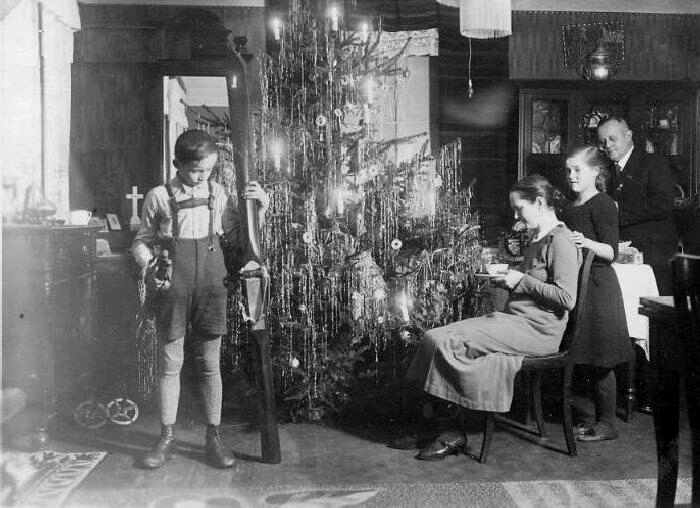
Figure 1.-- This scene of a German family Christmas was taken in 1937. The boy holds the skis he received for Christmas. I'm not sure what the boy has in his right hand. Notice the lit candles on the tree. |

|
Christmas is the most important German holiday. Thus images of German Christmas celebrations are particularly interesting. We have found a number of images which give us insights on German Christmas celebrations over time. We are not always able to tell if they are Catholic or Protestant fmilies. Perhaps our readers will be able to offer an insight here. Most of the images we have found center on the family Christmas tree, often when the children and their presents. While much has changed over time, the one constant seems to be the Christmas tree.
A ggod example of a German Christmas during the 1920s is a photograph of children in front of the family Christmas tree. The photograph was taken in 1923. The children are dressed up for the photograph. Rosmarie's brother is sitting on the floor in front of the Christmas tree.
This scene here of a German family Christmas was taken in 1937 (figure 1). The boy holds the skis he received for Christmas. I'm not sure what the boy has in his right hand. Notice the lit candles on the tree. The family here seems to be a Catholic family. A German reader writes, "I suppose it is a Catholic family. In the background you see a Christian cross. It would be very unusual for a protestantic family, we have a cross only in churches placed upon the altar."
The 1940s were not a happy decade for German and this was reflected in Christmas celebrations. The first half of the decade w were the War years. The War at first did not have a massive impact on the German family. And as a result of the short, successful campaigns in 1939 and 40, many servicemen wre able to get home for Christmas, And the ability to loot the economies of occupied Poland and Westen Europemeant that consumer goods were available for Christmas presents. This included both clothes and toys. We note two unidentified brothers who were smartly dressed for a Christmas portrait in 1942. This began to change in Germany as a result of the disaster in the Soviet Union (December 1941). This meant that many sons and fathers were not hime for Christmas for the first time. Hitler approved policies which attempted to supply food and consumer goods to maintain morale. Reverses in the East and then the West as well forced increased rationing. And casualties began to reach substantial levels. Further problens were created by the Allied stratehic bombing campaigns. Thus Christmas for the Germans got more and moregrim as the war progressed. The second half of the 1940s were the very difficult post-War years. Many fathers ad sons were killed, injured, or in POW camps. Even if the male family members survived the War, conditions were very difficult and jobs almost impossible to get. This did not begin to change until the currency reform and Marshall Plan launched the German Economic Miracle (1948). Germn was transformed on judt a few shot years. Mnyh viewinh the country's cities reducedd to rubble belived tht it woulkd take a genersatioin for tyhe country to rvoiver. The fices of free market capitalism ceated new Germny very quivckly, sat lest in the West. East Germany burdened by Comminism would be a very different story.
The free market reforms and American aid very quickly resulted in the German Economic Miracle which trasformed West Germany. ThevGerman economy respondedamazingly rapidly. To those who saw the emense piles of ruble which ha\d once been thriving cities, the speed of change was breath taking. Amazingly the piles of rubble disappeared more rapidly in Germany than Britain. (Surprising because the damage in West Germany had been on a much more massive scale. Progress in East Germany was also slower.) The German consumer who once faced shortages and emply shelves, not only found increasingly well-stocked shops and had the money to buy all kinds of consumer goods. No time is this more apparent than at Christmas. We see family Christmas images with loads of presents under the tree. And the trees are larger and more heavily decorated. Often before the War, Working class families often had small rather basic trees for the home. Sadly many fathers and older sons are absent from these 1950s Christmas photographs. In some cases father took the snapshots, but many others were lost in the War. And notably this is not only middle-class family, but working-class families as well. By the end of the decade, not only had the damage in German cities been repaired and ecnomic activity resumed, but German workers were much more prosperous than they had been before the War.
Navigate the Boys' Historical Clothing Web holiday pages:
[Return to the Main German Christmas page]
[New Years]
[Valetines]
[St. Patrick's Day]
[Easter]
[Fourth of July]
[Haloween]
[Thanksgiving]
[Christmas]
Navigate the Boys' Historical Clothing Web Site:
[Introduction]
[Activities]
[Biographies]
[Chronology]
[Clothing styles]
[Countries]
[Topics]
[Bibliographies]
[Contributions]
[FAQs]
[Glossaries]
[Images]
[Links]
[Registration]
[Tools]
[Boys' Clothing Home]
